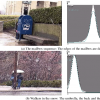Free Online Productivity Tools
i2Speak
i2Symbol
i2OCR
iTex2Img
iWeb2Print
iWeb2Shot
i2Type
iPdf2Split
iPdf2Merge
i2Bopomofo
i2Arabic
i2Style
i2Image
i2PDF
iLatex2Rtf
Sci2ools
112
click to vote
Publication
Rain or Snow Detection in Image Sequences through use of a Histogram of Orientation of Streaks
The detection of bad weather conditions is crucial for meteorological centers, specially with demand for air, sea and ground traffic management. In this article, a system based on computer vision is presented which detects the presence of rain or snow. To separate the foreground from the background in image sequences, a classical Gaussian Mixture Model is used. The foreground model serves to detect rain and snow, since these are dynamic weather phenomena. Selection rules based on photometry and size are proposed in order to select the potential rain streaks. Then a Histogram of Orientations of rain or snow Streaks (HOS), estimated with the method of geometric moments, is computed, which is assumed to follow a model of Gaussian-uniform mixture. The Gaussian distribution represents the orientation of the rain or the snow whereas the uniform distribution represents the orientation of the noise. An algorithm of expectation maximization is used to separate these two distributions. Following...
| Added | 12 Apr 2012 |
| Updated | 12 Apr 2012 |
| Type | Journal |
| Year | 2011 |
| Where | International Journal of Computer Vision |
| Authors | Jérémie Bossu, Nicolas Hautière and Jean-Philippe Tarel |
The bibtex reference is available at:
http://perso.lcpc.fr/tarel.jean-philippe/
http://perso.lcpc.fr/tarel.jean-philippe/
Comments (0)




